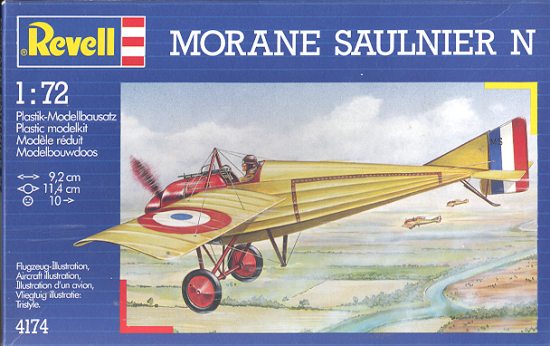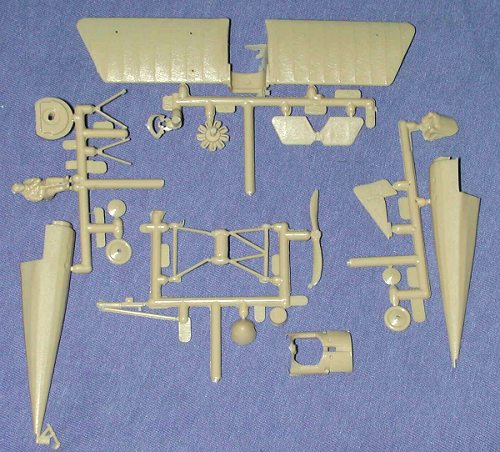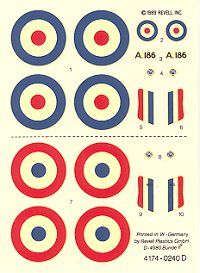
|
KIT: |
Revell 1/72 Morane-Saulnier type N |
|
KIT # |
4174 |
|
PRICE: |
$? |
|
DECALS: |
Two Aircraft |
|
REVIEWER: |
|
|
NOTES: |
1989 boxing |

|
HISTORY |
The Type N "Bullet" was a mid-wing monoplane, which became the first French fighter aircraft. Due to the shortage of decent fighting scouts from England, the British also used the "Bullet". The type N was fitted with a fixed Hotchkiss machinegun, but without a synchronization gear, as the Allies had not developed it yet. Instead the Bullet used metal bullet deflectors on the propellor blades instead, as pioneered by Roland Garros on a type L. However, this development was not very successful, as the impacts of the bullets on the deflectors could still shatter the propellor or weaken the motor mount, with disastrous results. Also, there were occasional rebounds of the bullets back at the pilot. While there was no indication that any pilot was killed from this, it was none-the-less a frightening situation. The Type N was less popular than the Type L "Parasol" monoplanes. This was mainly because, while faster, it was much more difficult to fly. The Type N did not fair very well against the Fokker Eindecker. One probable reason was that the wing on the Type N was not as large and so it was less maneuverable. Only some 49 were built in 1917. Aircraft development proceeded so fast that most planes were nearly obsolete when they reached the fighting squadrons at the front.
Technical Details
It was powered by the 110hp Le Rhone 9J rotary, air-cooled engine. This gave it
a speed of 165km/h, a ceiling of 4000m and a n endurance of 1h 30m. It was armed
with a single forward firing Hotchkiss machine gun using bullet deflectors on
the propeller blades.
|
THE KIT |

Back about thirty or so years ago, Revell decided to do a number of WWI aircraft in 1/72 scale. For the day they were superb little kits that could be built into very nice models. In addition to the usual Spad XIII, Sopwith Camel, Fokker D. VII, Albatros D.V and other 'normal' kits, Revell also produced some of the less well-known such as the DH.2, Eindekker E.III and this kit, the Morane-Saulnier type N.
 Molded in a dark ivory plastic
(undoubtedly to help with painting), this kit is still well done with minimal
flash. Of course, there are a few parts that suffer from ejector pin marks and
the ribbing may be a bit much, but overall it is a pretty clean kit. There is no
real cockpit, but as basic as these planes were, detailing one won't take much.
The metal deflection plates are molded on the back of the prop. They seem a bit
large, but I've not seen these things in person so can't comment on that.
Careful building will allow the rotary engine to spin. There is what appears to
be a windscreen frame, but no clear part. This can easily be made with clear
plastic sheet.
Molded in a dark ivory plastic
(undoubtedly to help with painting), this kit is still well done with minimal
flash. Of course, there are a few parts that suffer from ejector pin marks and
the ribbing may be a bit much, but overall it is a pretty clean kit. There is no
real cockpit, but as basic as these planes were, detailing one won't take much.
The metal deflection plates are molded on the back of the prop. They seem a bit
large, but I've not seen these things in person so can't comment on that.
Careful building will allow the rotary engine to spin. There is what appears to
be a windscreen frame, but no clear part. This can easily be made with clear
plastic sheet.
Instructions are totally pictorial in design. There is also a very good rigging diagram as this plane needs one. You can the box art as a help in this respect as well. Decals are for a French and a British plane. Both are natural linen in color a red nose and wheels. The decals are well printed, very matte and have yellowed just a touch over the last decade or so. The blue looks a bit dark to me as I thought RFC blue was a touch lighter in shade, but WWI aircraft are not my strong suite so I'll assume the color is correct.
|
CONCLUSIONS |
I'm not a WWI buff, but it looks like this can be made into a super little model. As with all these WWI types, the ability to do rigging is paramount if you want a realistic looking plane. Though it does show its age in some areas, in others it is very well done.
|
REFERENCES |
Jane's Encyclopedia of Aviation, 1991
If you would like your product reviewed fairly and fairly quickly by a site that has well over 150,000 visitors a month, please contact me or see other details in the Note to Contributors.